For more information than you probably care to know about tires, check out RV Tire Safety.
On this page:
Tire and Wheel Sizes and Load Requirements
|
Model Year 1996-2001 Rialta Tire Sizes:
|
| |
Front Axle
|
Rear Axle
|
| Series |
"Contrans"
|
"VANCO" or "Contrans" |
| Tire Size |
195/70R15C |
215/70R15C
|
| Tread plies |
5 Total (2 polyester, 2 steel, 1 nylon) |
6 Total (2 polyester, 2 steel, 2 nylon) |
| Sidewall plies |
2 polyester |
2 polyester |
| Load Index |
104 |
109 |
| Wheel size |
15x6J |
15x6J |
|
Model Year 2002-2005 Rialta Tire Sizes:
|
| |
Front Axle |
Rear Axle |
| Series |
"VANCO"
|
"VANCO" |
| Tire Size |
195/65R16C (Commercial) |
215/65R16C (Commercial)
|
| Tread plies |
6 Total (2 polyester, 2 steel, 2 nylon) |
6 Total (2 polyester, 2 steel, 2 nylon) |
| Sidewall plies |
2 polyester |
2 polyester |
| Load Index |
104 |
109 |
| Wheel size |
16x6J |
16x6J |
The above data are taken from the Winnebago Chassis Spec Sheet and the Winnebago
GVWR/GAWR sticker.
The letter C after the rim diameter in the "tire size" as shown
above is the European designation for a "Commercial Light Truck or Van" tire.
The Load Index numbers are the European Load Index similar to the US designation
of "Load Range D". The letter R is the European speed design rating of the tire.
Additionally, the Continental tires may have markings on the tires themselves
that are slightly different than the limits given by Winnebago as shown in the
table above. For example, on the model year 2002 Rialta, the rear tires are actually
marked with a load index of "109/107R". The Maximum Load ratings are
marked on the tires as 1,984# at 70 PSI for the front tires and 2,271# at 70 PSI on the rear.
Specific values of various load indexes are shown in the "Load
Index Chart".
Continental
Tire Product Guide 2005 (Complete Line, 47 pages, 5.96 megs) PDF
Continental
Vanco Series Tire Guide 2005 PDF
Continental
Vanco-8 Tire Datasheet 2006 PDF
[ return to top ]
Tire Inflation Recommendations:
Winnebago recommends a tire inflation of 60 PSI on all four tires. In all cases,
the Vehicle Certification Label is located on the sidewall to the left of the
steering wheel, or on the driver's door. The label gives the exact tire size and
minimum cold pressure required for your vehicle. There have been no notices of changes from
either VW or Winnebago relating to required sizes or tire pressures.
The SPARE tire is the smaller size made for the FRONT axle. You can use it
on the REAR axle temporarily provided it is inflated to the maximum shown on the sidewall.
Should you use nitrogen in your tires? Simple answer: No. More details: Video
[ return to top ]
Tire Rotation:
Do NOT follow the rotation pattern given in the VW EuroVan
Operator's Manual if you are still using the original size tires as equipped from
Winnebago. The reason is that unlike the EuroVan, the Rialta has two different
size tires and the different sizes should not be inter-mixed on the axle. On the
other hand, if you have replaced your front tires with the same size and load
rating as used on the rear tire, then a conventional rotation pattern as shown
in the EuroVan Operator's Manual may be used.
Ideally radial ply tires are usually rotated on the vehicle
so that they continue to turn in the same direction as they go down the road.
However, since the Rialta uses two different sizes of tires such rotations can
not be accomplished without having a complete separate set of tires. It is for
this reason that there is no recommended method of rotating tires on the Rialta
without the use of another complete set of matching tires.
An alternative method of rotating tires involves simply moving
them from side to side. Most users have reported no adverse effects when rotating
the tires from the left side to the right side. Because this causes the tire to
rotate in the opposite direction, theoretically there is the possibility of adverse
ply flexure occurring. However, I have rotated my own tires from side-to-side
and felt no obvious effects. I expect my original "Contrans" tires to provide
up to 60,000 miles of use. But I check my inflation pressures religiously.
If you rotate your tires in this side-to-side manner and immediately
feel any noticeable vibrations or changes in handling, it is suggested that you
immediately return the tires to their original positions. Your tires apparently
will function just fine as long as you keep the rotational direction the same.
If and when you are ready to replace the tires, it is recommended
that you use the original (smaller) spare tire as one of the front tires assuming that it
has seen only minimal service. This prevents the rubber compounds from eventually
breaking down over the years and making the tire ultimately un-useable.
[ return to top ]
Tire Load Index Chart:
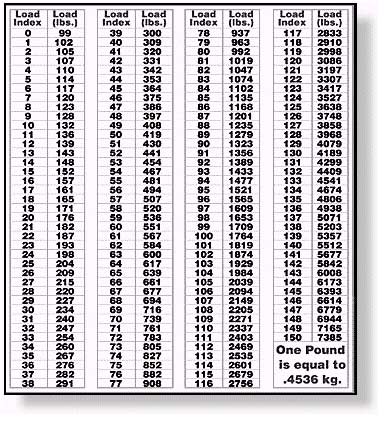
What this means is that two tires of the correct Load Index
rating should hold up to the maximum axle weight allowed for the vehicle. For
example, the rear axle of the Rialta has a Gross Axle Weight Limit of 3,968. Since
the axle uses two tires, then each tire must be capable of holding up 50% of the
weight, or 1,984 pounds. If you look at the chart, you'll see that 1,984 pounds
indicate a Load Index of 104. The specified OEM Continental tire for the Rialta
has a Load Index of 109 so it more than meets the requirement and there is some
margin of safety in case of an overload.
[ return to top ]
Tire DOT Code (Manufacturers) Disclosures:
If you are confused by or doubt the claims by a tire salesman
as to the true manufacturer of a 3rd party or "branded" tire, just read the "DOT"
code on the side and compare to this list. For example, you'll find that many
of Big-O tires are made by Kelly-Springfield even though the salesman may have
verbally told you they were made by Michelin.
You may wish to use the search or find function of your browser.
With Internet Explorer, it is under the EDIT Menu / .(FIND (on This Page)...Or
hit CTRL-F and then type in the two letter code that you wish to locate. View
the list sorted by either the DOT Code or by the manufacturer's name:
Sorted by DOT CODE
Sorted by Manufacturer's
Name
[ return to top ]
Replacement Tires
First, left me dispel some false ideas that others have about
finding suitable tires. "Ply ratings" are totally meaningless. They are not regulated
by the DOT so therefore they are merely one manufacturer's advertising and marketing
gimmick when they talk about ply ratings. Is an eight-ply tire stronger than
a four-ply tire? One can't answer the question because once again "ply ratings"
are meaningless. To be specific, what are the plies made of and how strongly have
the plies been tested (they haven't because they are not directly regulated)?
In my example, the eight-ply tire could be all eight plies of cotton while the
four-ply tire could all be all steel-reinforced nylon which would probably make
the four-ply tire stronger than the eight-ply tire. If you want to rate the strength
of a tire in regards to how much load it can handle, you MUST compare the LOAD
INDEX RATING of the tire.
Replacement tires are available from a variety of sources such
as Sears, Wal-Mart, and any tire store than sells Continental, Goodyear, Nokian,
Maxxis and a few other brands which make tires capable of handling the load requirements
of a Rialta. Expect to pay about $150 or more per tire but other bargains are out
there. Also, when comparing prices, try to compare the price which represents
your final, total cost which would include not only the tire, but extras such
as mounting, valves, freight, balancing, and old tire disposal fees. Many people
think they find bargain prices at the TireRack.com but have not taken into consideration
any of these factors.
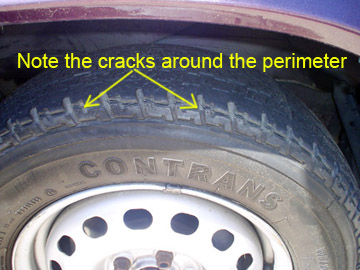 |
The original Continental Contrans tire suffered from
premature tire deterioration and was the subject of a recall on 1995 through
1998 models (see the NHTSA
Recalls page). The tires showed marked evidence of separation of the
tire tread from the sidewall body as shown on this photo. The recall or
the deterioration did not affect the Continental Vanco series of tires which
has proven to be a very reliable and sturdy tire.
|
I have put together what I think is a list of available tires
including different brands other than Continental. Because the late model Rialtas
changed from 15 inch tires to 16 inch beginning in 2002, there are two separate
charts. Each chart also includes what I consider an acceptable substitute by upsizing
the tire by one or two increments, i.e. 195-70 can safely use 215-70. We know
this works because many Rialta owners are using all four tires of the larger size
normally found on the rear axle. The larger 215-70 fits within the wheel well
of the front axle and does not bind against the suspension parts or the inner
fender. The only reason that a smaller size was used up front is because that
is what VW supplied on the incomplete EuroVan chassis. After Winnebago fitted
the rear coach area, they had to use a larger tire to support the weight and they
ordered the tires direct from Continental and not VW. Please note that I
make no guarantee that any size other than the factory original size will be a
proper fit.
The Nokian and Maxxis tire brands have very limited retail
outlets, especially the Maxxis brand, whose manufacturer is actually the Cheng-Shin
Rubber Company of China, and a company whose previous experience was limited mostly
to motorcycle and ATV tires. Their venture into automotive tires is relatively
new in the US and their sales territory is mostly limited to the southeast portion
of the United States with their corporate headquarters located in Georgia.
I would appreciate anybody notifying me of any corrections
or if they have another tire brand that should be added. Please be sure to include
the COMPLETE tire brand and model, i.e. instead of just "MAXXIS", it should
be something like "Maxxis UE-168 Bravo".
Rialta Model Year 1996-2001
|
Size
|
Load Index
Single Tire Axle
|
FRONT AXLE OEM SIZE:
|
195 / 70 - 15"
|
104
|
- Continental VANCO-8 (OEM)
|
195 / 70 - 15" |
104 |
- Continental VANCO 4 Season
|
195 / 70 - 15" |
104 |
|
|
195 / 70 - 15" |
104 |
|
|
195 / 70 - 15" |
104 |
|
|
195 / 70 - 15" |
104 |
|
|
195 / 70 - 15" |
104 |
| substitutes using REAR AXLE OEM size: |
|
|
|
|
215 / 70 - 15" |
109 |
|
|
215 / 70 - 15" |
109 |
| ***1 - See Special
Notes below |
|
|
REAR AXLE OEM SIZE:
|
215 / 70 - 15"
|
109
|
- Continental VANCO-8 (OEM)
|
215 / 70 - 15" |
109 |
|
|
215 / 70 - 15" |
109 |
|
|
215 / 70 - 15" |
109 |
| substitutes using slightly larger size: |
|
|
- Continental VANCO 4 Season
|
225 / 70 - 15" |
112 |
|
|
225 / 70 - 15" |
112 |
|
|
225 / 70 - 15" |
112 |
|
|
225 / 70 - 15" |
112 |
|
|
225 / 70 - 15" |
112 |
|
|
225 / 70 - 15" |
112 |
Rialta Model Year 2002-2005
|
Size
|
Load Index
Single Tire Axle
|
FRONT AXLE OEM SIZE:
|
195 / 65 - 16"
|
104
|
- Continental VANCO-8 (OEM)
|
195 / 65 - 16" |
104 |
|
|
195 / 65 - 16" |
106 |
| substitutes using slightly larger size: |
|
|
- Continental VANCO 4 Season
|
205 / 65 - 16" |
107 |
|
|
205 / 65 - 16" |
107 |
| substitutes using REAR AXLE OEM size: |
|
|
|
|
215 / 65 - 16" |
109 |
- Nokian WR CVan (All weather)
|
215 / 65 - 16" |
109 |
|
|
215 / 65 - 16" |
109 |
| |
|
|
REAR AXLE OEM SIZE:
|
215 / 65 - 16"
|
109
|
- Continental VANCO-8 (OEM)
|
215 / 65 - 16" |
109 |
- Nokian WR CVan (All weather)
|
215 / 65 - 16" |
109 |
|
|
215 / 65 - 16" |
109 |
|
|
|
|
*** Special Notes:
-
For those with 15" wheels, we all know that the rear 215/70
size can also be used up front. Some others report using a 225/70 size Goodyear
tire. This is a tire that is about 6% larger in diameter than the original.
-
For those with 16" wheels, I'm wondering if any of the
front axle substitutes with a size of 205/65-16" instead of the OEM size 215/65-16"
also work for the rear axle? The 205/65 tire is about 1/2" narrower but it
may meet load requirements.
[ return to top ]
Rear Wheel Bearing
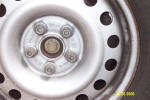
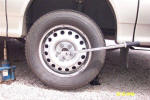 A Winnebago Rialta engineer has confirmed the correct torque
value of 148 ft. lbs. for the rear wheel center bolt. He also stated that in the
case of many Rialtas they probably loosen because of repeated heating and cooling
of the bolt and associated parts which causes shrinkage of the metal. There is
no positive locking mechanism such as a castellated nut and cotter key in the
system, only a nut with a serrated surface that digs into the back of the brake
and wheel assembly. Some can be tightened just by turning the bolt from the front.
Others may just turn round and round and you may have to hold the nut from turning
on the back with an additional wrench. I would caution everyone to periodically
check the tightness of these wheel and bearing retaining bolts just to be sure
that a rear wheel does not come off.
A Winnebago Rialta engineer has confirmed the correct torque
value of 148 ft. lbs. for the rear wheel center bolt. He also stated that in the
case of many Rialtas they probably loosen because of repeated heating and cooling
of the bolt and associated parts which causes shrinkage of the metal. There is
no positive locking mechanism such as a castellated nut and cotter key in the
system, only a nut with a serrated surface that digs into the back of the brake
and wheel assembly. Some can be tightened just by turning the bolt from the front.
Others may just turn round and round and you may have to hold the nut from turning
on the back with an additional wrench. I would caution everyone to periodically
check the tightness of these wheel and bearing retaining bolts just to be sure
that a rear wheel does not come off.
I would also advise the use of Loctite®
or a similar thread holding compound around the threads of the nut on the inside
before you begin to tighten. The Loctite®
will serve as the only means which will keep the bolt and nut from becoming loose
again. When replacing the bearing, it comes with a new nut, so using the old one to double-nut is possible.
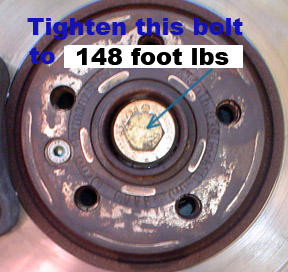 |
|
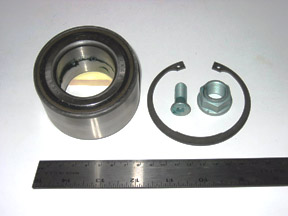 |
| This photo shows which nut is
to be turned in order to set the proper load on the wheel bearing. |
|
This photo shows a replacement
wheel bearing, nut, retaining screw, and circlip. |
[ return to top ]
Wheel Covers
There was a recall on the wheel covers of the 2002 Rialta caused
by a cheaper cover being used which did not grip the wheel with sufficient force
causing the cover to rotate and potentially cut the valve stem (details on the
NHTSA Recalls page). Otherwise,
many other owners of Rialtas have been somewhat dissatisfied with the covers as
supplied by Winnebago.
If you lost one of the original covers, you may be able to
purchase a replacement from Winnebago through a dealer, but
most people find it cheaper to visit their local Wal-Mart or other auto parts
store and buy a full new set of 4 covers at a cost of well under $50 total.
Removing the covers and painting the wheels is another option.
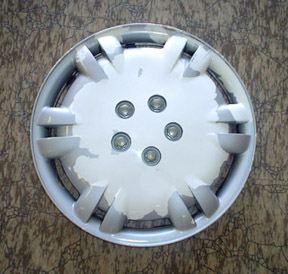 |
Part of the reason with dissatisfaction comes from the fact that the
original plastic Taiwanese covers came with a paint that had a tendency
to peel off even under the pressure of a garden hose as shown on this picture.
With a little bit of fine sanding, such covers can be repainted but unless
you repaint all four, the color will never match the original. |
[ return to top ]
| 